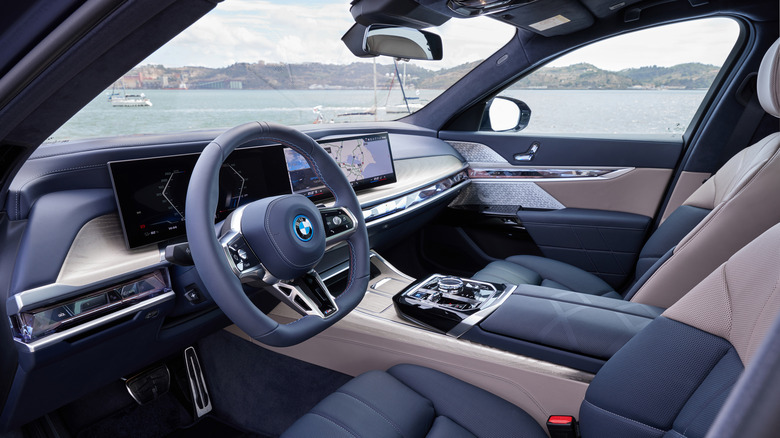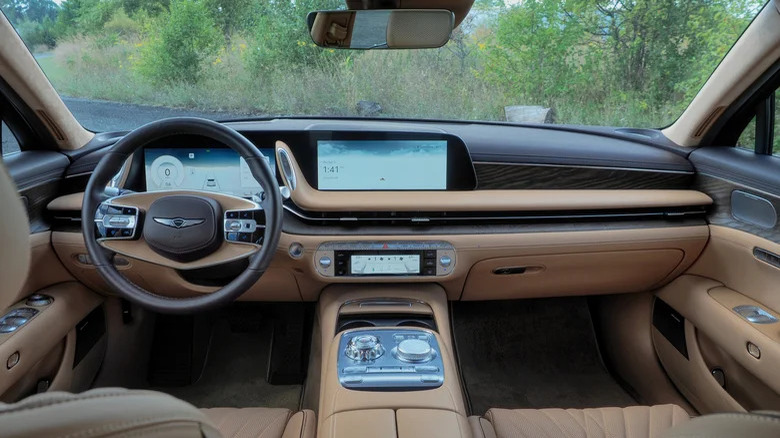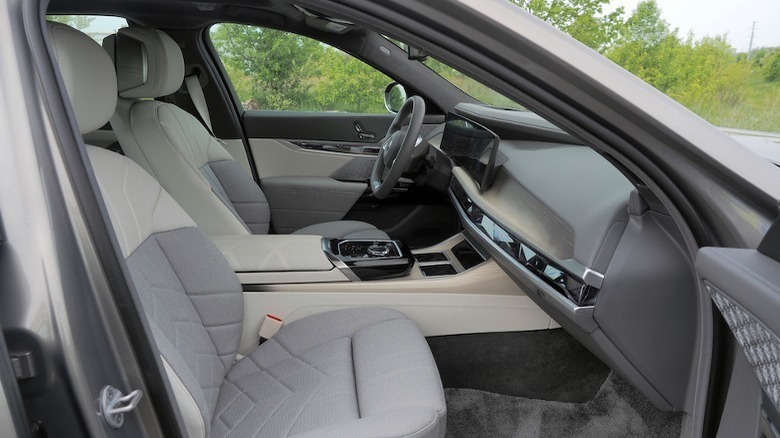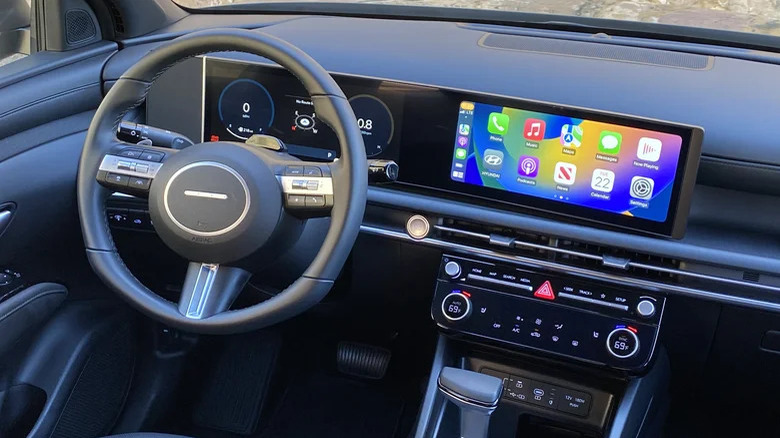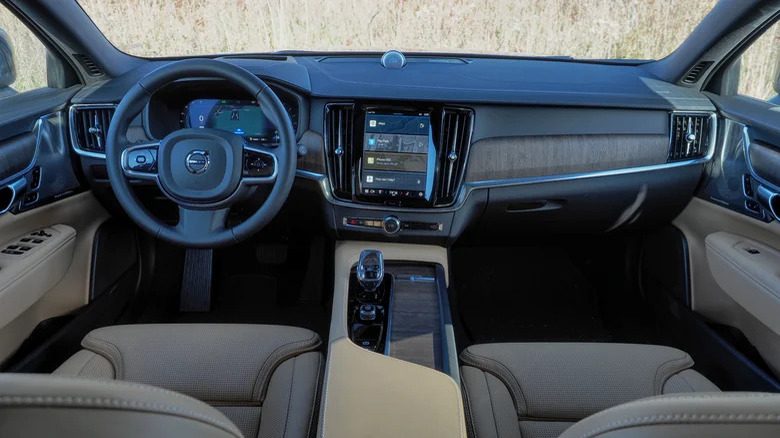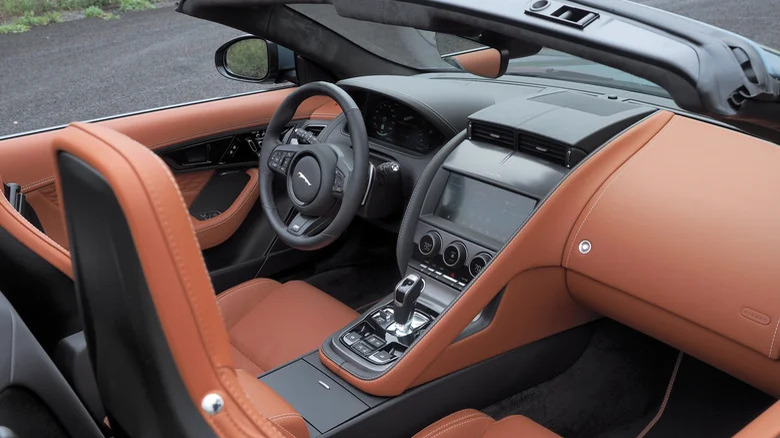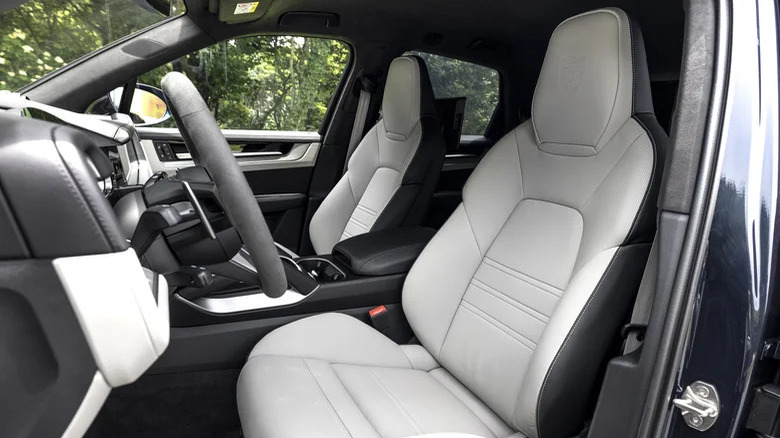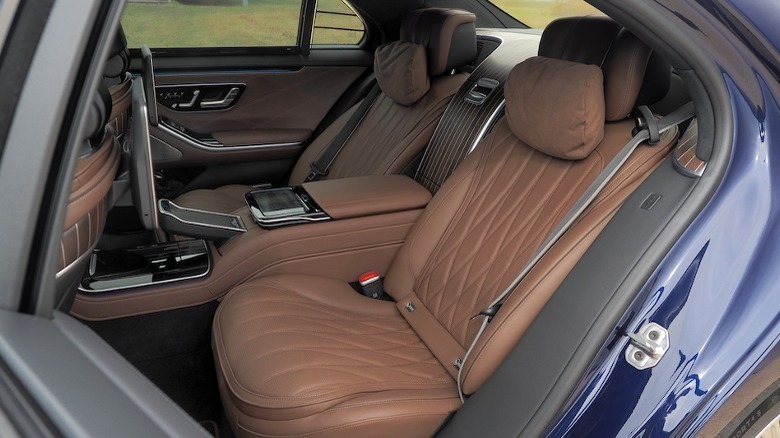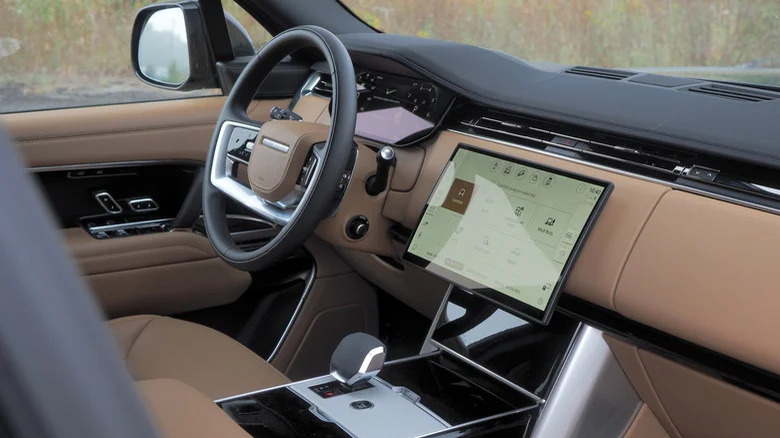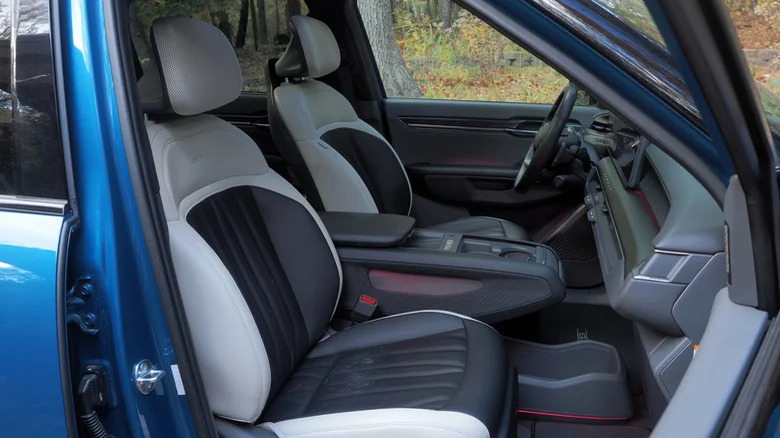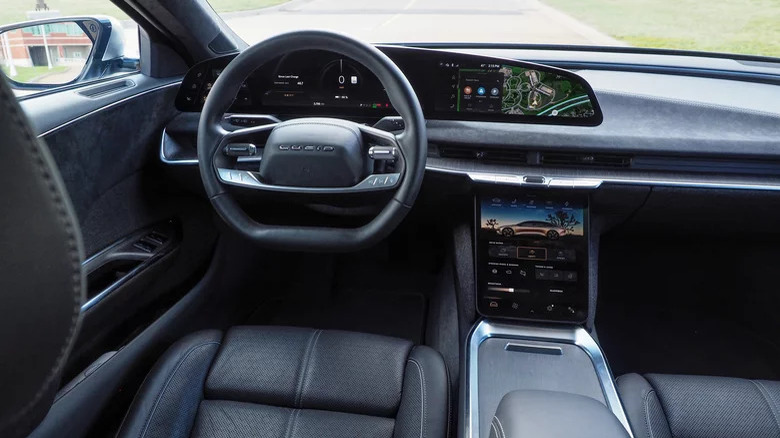10 Car Brands With The Nicest Interiors
According to a study conducted by AAA, the average American spent around 60 minutes per day driving in 2023. Drivers aged 35 to 49 spent the longest of all groups, reporting an average driving time of 72 minutes per day, adding up to 438 hours annually. With so many people spending so long at the wheel, it's no surprise that many drivers are keen to shop around for cars with the best cabins on the market.
SlashGear's test team reviews a huge array of cars every year, and as a result, has put the latest models from almost every major manufacturer through their paces. These 10 manufacturers all scored particularly highly with our reviewers for their interior, being comfortable, generously sized, and generally pleasant to spend time in. This list isn't exhaustive, but it covers a wide range of price brackets, from budget-oriented to luxury brands, with each brand being among the nicest within its part of the market.
Genesis
Hyundai's luxury arm might still be the new kid on the block compared to its German and Japanese rivals, but the South Korean automaker has already proved that its cars can hold their own against the competition. In a review of the brand's flagship G90 sedan, SlashGear noted that the car's cabin was both quiet and lavishly appointed, with a pleasing mix of physical buttons and switches as well as touchscreen controls. Easily accessible controls were a concern on the luxury segment benchmark, the Mercedes S-Class, as the German brand's insistence on hiding many functions behind a touchscreen menu sometimes rankled drivers.
Further down the Genesis range, its cabins are no less impressive. SlashGear was impressed with the interiors of both the GV60 crossover and the BMW 3 Series-rivalling G70 sedan, although our reviewer noted that longer-legged drivers might find the latter less roomy than the Bimmer. As well as being generally very comfortable, Genesis' cabins tend to be well equipped across the whole trim range, with even lower spec trims benefitting from a generous helping of safety and infotainment tech as standard.
BMW
Long considered a benchmark brand in its corner of the market, BMW has built up a hard-earned reputation over the decades for its comfortable cabins. Leaning into its historic slogan as the ultimate driving machine, BMW's interiors are generally built with spirited driving in mind, with seats designed to provide ample support when carving through backroads as well as remaining cosseting when clocking up miles on the highway. Of course, M-badged models lean towards the former to varying degrees, while luxury-oriented models like the flagship 7 Series lean more towards the latter.
This focus on both performance and comfort remains true across the brand's wide-ranging lineup. That includes its crossovers and SUVs such as the X6 xDrive40i, which SlashGear's reviewer described as both "indulgent and thoughtful." While that car's features and finish were comparatively flashy, even more everyday models like the 530i xDrive still benefit from the brand's slick balance of aesthetics and functionality. BMW's cars might cost a lot even in lower-spec form, but for those who can justify the outlay, they consistently feature some of the nicest cabins in their respective segments.
Hyundai
There was once a time when buying a budget-oriented car meant sacrificing any hope of a premium-feeling cabin. That time is no longer, since brands like Hyundai have been instrumental in implementing more upscale interiors even in their cheaper models. For example, SlashGear thought that the Santa Cruz pickup was among the most comfortable trucks in its class, with minimal road noise and generous levels of assistive tech and infotainment equipment as standard. Similar praise can be given to the recently redesigned Santa Fe SUV, which now boasts a cabin that takes a leaf out of Land Rover's design book and feels all the better for it.
The model's top trims also get premium extras that were once the preserve of the segment above, such as ambient lighting. Materials throughout the cabin are generally typical of what else is offered at each model's price point — there's no real wood or metal trim to be found across any of Hyundai's value-oriented cars — but with cars like the Kona N-Line, it's not like that matters anyway. There, the car's minimalist cabin and thoughtfully designed mix of touchscreen and button controls put the car a step above most of its competition without the need for any fancier interior materials.
Volvo
While they might not be the most attention grabbing nor the most opulent of their kind, Volvo's interiors are consistently enjoyable places to be. Even in smaller, cheaper models like the XC40 Recharge, there's a sense of clever Swedish minimalism, with every aspect of the layout clearly having been thought out by its designers. Step up to a larger model like the S60 Recharge and that feeling remains consistent, except now the cabin benefits from an extra helping of premium materials and tech.
The brand's crystal shifter knob has become an increasingly common feature in the brand's models in recent years, and adds a dash of lavishness to what's otherwise a very understated cabin. Look around the interior and the materials you see are largely the materials you get — unlike other brands, which can skimp on pricier furnishings like real wood and metal trim, there's no plastic faux-wood or faux-metal to be found here.
It's not without its flaws: in a review of the V90 Cross Country, SlashGear noted that Volvo's infotainment system still isn't the sleekest on the market, for example. Overall though, there's little to dislike about the brand's distinctly Swedish approach to interior design.
Jaguar
With its endlessly controversial reinvention stealing the limelight, it can be easy to forget that Jaguar is still in the process of winding down its current production lineup, and thus still makes cars as of this writing. Sure, the final F-Type has already left the production line, as has the I-Pace EV, which ended production in December 2024. However, as of this writing, the F-Pace SUV remains in production for select markets, with the last example scheduled to roll off the line sometime in the first half of 2025.
Although its sales figures have never reached the highs that company bosses were hoping for, Jaguar's cars have had plenty to offer to those that did buy them. The brand overhauled all its interiors around the turn of the decade, taking inspiration — and in some cases, parts — from sister brand Land Rover. The resulting cabins are consistently welcoming, comfortable places to spend time, even if the brand's impending reinvention means that they'll soon only be available to sample in second-hand guise.
Porsche
Porsche's interiors vary in their feel across the current model lineup. SlashGear felt that the automaker nailed the balance of cutting-edge tech and driver-oriented design in the electric Taycan GTS, while the track-oriented 911 GT3's stripped-back interior still managed to feel more premium than other weekend track toys. In the latest Cayenne GTS, the brand's family hauling SUV, the generously sized cabin is filled with plenty of touchscreen-based tech, but there are still also enough physical buttons to prevent the driver becoming too distracted while on the road.
No matter whether a Porsche model sits closer to the performance or the luxury end of the spectrum, its cabin is unilaterally inviting. Just be aware — buyers who have to have all of the optional trappings should expect to set aside a significant budget to do so, as option packs can very quickly add up. Just to take one example, even an optional leather key fob for the Cayenne GTS costs around $1,000.
Mercedes-Benz
Of all the German manufacturers, it's Mercedes-Benz that has leaned the heaviest into festooning its cars with huge screens in recent years. The MBUX Hyperscreen that can be found on models such as the EQS SUV is a particularly divisive addition — some will love its futuristic, car-spanning look, while others will find it a distraction — but even models without a Hyperscreen aren't short on screen acreage. The Mercedes-AMG S63 E Performance, for example, has two screens within sight of the driver, a 12.8-inch central touchscreen and a 12.3-inch virtual instrument cluster.
Love them or loathe them, the brand's penchant for screens give its cars a modern, forward-looking feel, and its other interior design motifs have also proved pioneering. The cabin-spanning ambient lighting has been available for years now on models from base-spec sedans up to the giant GLS 4Matic. It's a feature that's been copied by other manufacturers keen to emulate a premium feel, most notably Hyundai. However, plenty of other features, such as the S63 E-Performance's optional aircraft-style rear executive seats, remain exclusive to the brand and accordingly pricey.
Land Rover
While some Land Rover and Range Rover buyers will be purchasing their cars because of the reassurance that all-terrain capability brings, the reality is that most of them will never venture much off the asphalt. Many more buyers cough up the cash for one because of the brand's lavish, elegant interiors, which are at their finest in the full-fat Range Rover. Cheaper Range Rover models like the Range Rover Velar offer a slightly less opulent take on the brand's cabin design, while top-spec variants of the Land Rover Defender can get very close to matching the luxury of their Range Rover-branded siblings.
Buying any Land Rover will potentially flag up questions about its reliability and long-term running costs, but that doesn't stop buyers from snapping them up anyway. Their cabins are simply too good to ignore, combining modern luxury with a sense of timeless style and craftsmanship. Even with its patchy reliability reputation, it seems buyers can't get enough of the British brand, and its revenue figures reflect that.
Kia
Much like its sister brand Hyundai, Kia has carved out a reputation for itself as offering cabins with nicer furnishings and equipment than its cars' price tags would suggest. This is evident both in its newest models, like the EV9, to which SlashGear gave an exceptional 10 out of 10 rating, and in more established models like the Telluride. Both offer a set of features in their highest trims that are more commonly found in premium or luxury vehicles, while lower trims remain competitively equipped even if they're not as upscale.
Crossovers and SUVs make up the bulk of Kia's range, but its sedans such as the K5 GT aren't left out either. Equipment varies significantly by trim, but the top-spec GT trim offers dual 12.3-inch screens, a Bose audio system, and a 360-degree camera. Unlike some competitors, the cabin also still features buttons for most of its core controls, so there's no need to take your eyes off the road while driving.
Lucid
While it's still a relatively small player in the EV market in terms of volume, Lucid has consistently wowed SlashGear's testers with its cars. Its latest model, the Gravity SUV, began production at the end of 2024, while its Air sedan has been in production for several years. SlashGear's executive editor Chris Davies has spent time putting several variants of the Air through their paces, including the entry-level Air Pure and the six-figure Air Grand Touring Performance.
Each time, the verdict is the same — the car's cabin is a winner, with more space for passengers than similarly sized rival EVs and fit and finish that's comparable with benchmark luxury models from Mercedes-Benz. Real wood, Nappa leather, and Alcantara can be found throughout, yet the cabin doesn't feel lavish or overly showy. It's more understated than many luxury interiors, yet it doesn't fall prey to the touchscreen-only minimalism that has proved so divisive in Tesla's cabins.
The only catch is that, for now at least, buyers will have to have a suitably healthy wallet to step into one. The brand's entry-level Air stickers at around $80,000, and top-speed models can reach up to $250,000.
